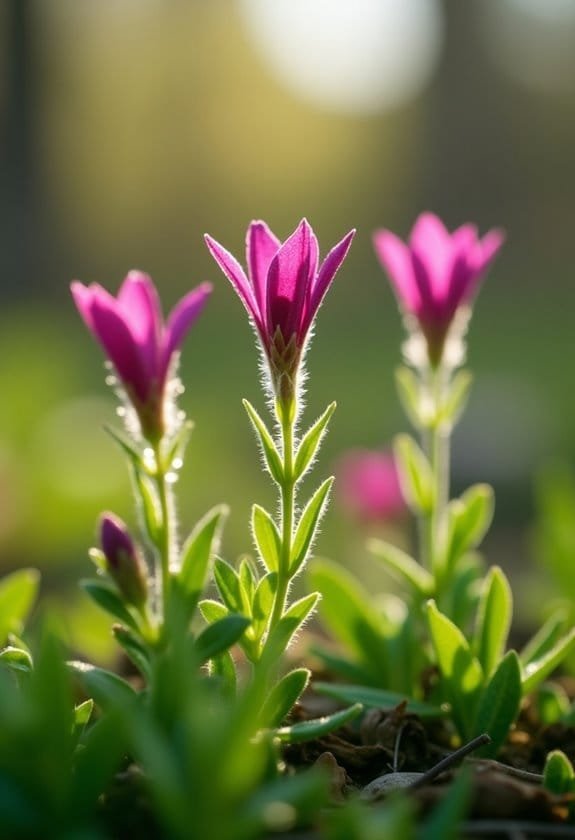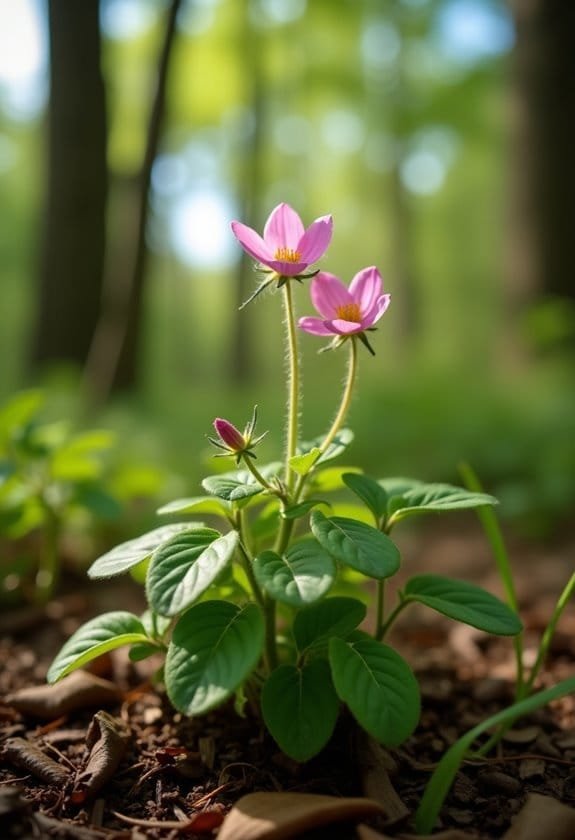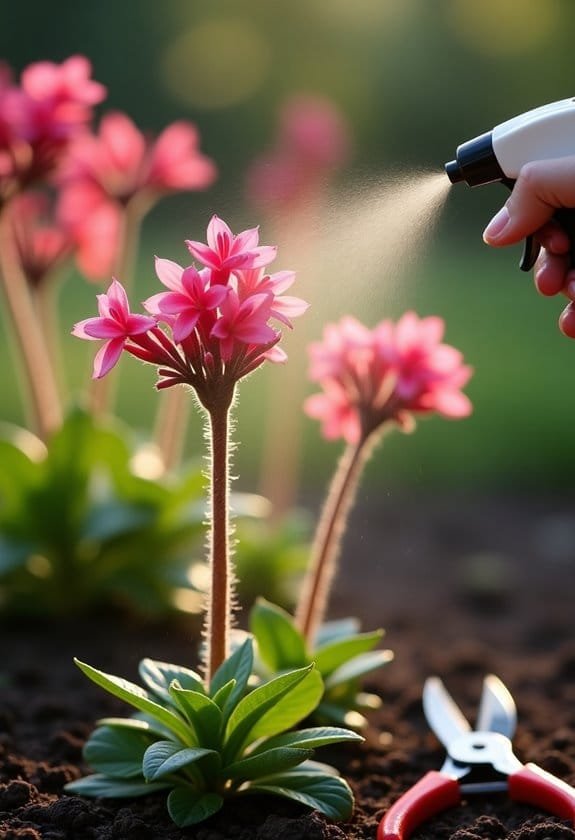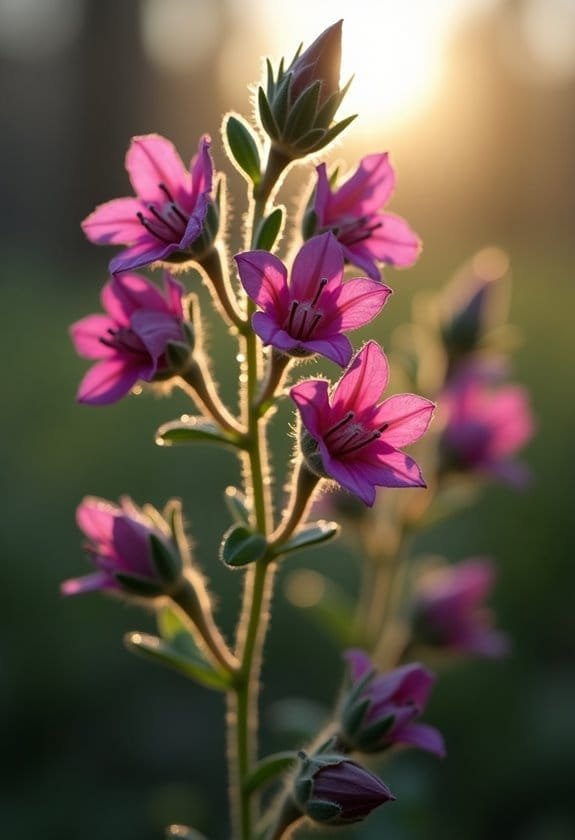Red Campion (Silene dioica) is a resilient semi-evergreen perennial that graces gardens with its vibrant pink-red blooms from May through October. This dioecious plant, reaching heights of 2-3 feet, features distinctive inch-wide flowers and downy, spoon-shaped leaves measuring 3-8 cm. It's a low-maintenance species that thrives in well-drained soils and adapts to both full sun and partial shade conditions. As a cornerstone species for biodiversity, Red Campion serves as a crucial nectar source for long-tongued bumblebees and other pollinators, while its separate male and female plants guarantee genetic diversity through cross-pollination. Understanding its unique characteristics reveals why this wildflower has become fundamental for wildlife-friendly gardens.
Main Points
- Red Campion is a semi-evergreen perennial reaching 2-3 feet tall, featuring pink-red flowers and downy, spoon-shaped leaves.
- It's a dioecious plant with separate male and female plants, requiring cross-pollination primarily facilitated by long-tongued bumblebees.
- The plant blooms from May through October, producing star-shaped flowers with five deeply forked petals that attract pollinators.
- It thrives in well-drained, moderately fertile soil and adapts well to both full sun and partial shade conditions.
- Red Campion supports biodiversity by providing essential nectar for bees and butterflies while serving as a host plant for moths.
Introduction

Red Campion (Silene dioica) stands as a graceful semi-evergreen perennial that graces European landscapes with its distinctive pink blooms and downy foliage.
This resilient plant, reaching heights of 2-3 feet, creates stunning displays in gardens and natural settings with its delicate inch-wide flowers that emerge from late spring through early summer.
As a dioecious species, Red Campion maintains separate male and female plants, each contributing to its successful reproduction through a fascinating pollination process that relies on various beneficial insects.
Common Name
Known throughout Europe as Red Campion, Silene dioica is a flowering plant that goes by several traditional names including Adders Flower, Devils Flower, and Poor Robin. These varied common names reflect the plant's cultural significance and historical presence across different regions of Europe, particularly in the British Isles.
The name "Red Campion" most accurately describes the plant's distinctive appearance, referring to its vibrant pink-red flowers that grace woodlands and hedgerows during the growing season.
While "red" might seem a simplistic descriptor, it serves as an essential identifying feature that distinguishes this species from its close relatives in the Silene genus.
The alternative names paint a more colorful picture of the plant's folklore connections, with "Adders Flower" and "Devils Flower" suggesting mysterious or potentially dangerous associations in traditional belief systems.
The humble moniker "Poor Robin" offers a contrasting perspective, perhaps alluding to the plant's common occurrence along roadsides and in marginal areas, where it provides valuable nectar resources for various pollinators.
Scientific Name
Beyond its common names, this flowering plant carries the scientific designation Silene dioica, belonging to the pink family Caryophyllaceae. The scientific nomenclature reflects one of the species' most distinctive characteristics, as the name "dioica" originates from Greek, meaning "two houses," which perfectly describes its separate male and female flowers.
Throughout botanical history, scientists have classified this species under different names, including Lychnis dioica and Melandrium dioicum, though Silene dioica remains the accepted scientific designation today.
The plant's ability to produce viable Red campion seeds through cross-pollination has made it particularly interesting to botanists studying plant reproduction.
What's especially fascinating about Silene is its capacity to hybridize with related species, most significantly Silene latifolia, resulting in offspring that showcase a blend of parental traits.
This natural hybridization process demonstrates the dynamic nature of plant evolution and the complexity of species boundaries within the Caryophyllaceae family. These genetic interactions have provided valuable insights into plant breeding patterns and species development in flowering plants.
Overview
Throughout woodland edges and meadows across Europe, Silene dioica stands as a graceful semi-evergreen perennial, enchanting observers with its vibrant pink blooms and distinctive growth pattern. This resilient plant reaches heights of 2-3 feet, adorned with downy, spoon-shaped leaves that create an attractive foundation for its delicate flowers.
The Red campion flowers emerge in late spring, producing charming blooms approximately one inch across that persist through early summer, with occasional displays extending into autumn. As a dioecious species, the flowers grow on separate male and female plants, facilitating efficient cross-pollination through the activity of various insect visitors. This reproductive strategy has proven remarkably successful in maintaining genetic diversity within populations.
In garden settings, Silene dioica demonstrates remarkable adaptability, flourishing in well-drained soils under varying light conditions from full sun to partial shade.
Once established, it exhibits impressive drought tolerance while serving as a crucial nectar source for pollinators. The plant's ability to attract bees and butterflies makes it an excellent choice for biodiversity-focused gardens and natural landscaping projects.
Key Features
Red Campion stands as a striking semi-evergreen perennial, reaching heights of 2-3 feet (60-90 cm) and forming robust clumps adorned with downy, spoon-shaped leaves.
The plant's signature pink flowers, measuring approximately 1 inch (2.5 cm) across, grace gardens from late spring through early summer, with occasional blooms persisting into fall.
Its dioecious nature presents an intriguing botanical feature, as male and female flowers develop on separate plants, with male blooms sporting 10 prominent stamens while female flowers showcase 5 distinctive styles.
Growth Size
At maturity, Red Campion reaches an impressive height of 2 to 3 feet (60 to 90 cm) while spreading up to 2 feet (60 cm) wide. This robust growth pattern creates a substantial presence in garden spaces, with the plant developing a well-balanced, bush-like form that provides excellent coverage for borders and naturalized areas.
The plant's growth structure is characterized by its distinctive foliage arrangement, featuring downy, spoon-shaped leaves that emerge in opposite pairs along the stems. These leaves, measuring between 3 to 8 centimeters in length, contribute considerably to the plant's overall architectural form.
During the peak growing season, the striking pink flowers, each measuring approximately 2.5 centimeters across, emerge abundantly throughout the plant's upper portions, creating a visually appealing display that enhances its dimensional presence.
As a semi-evergreen perennial, Red Campion maintains its size and structure throughout much of the year, though it may become slightly more compact during dormant periods. The plant's moderate growth rate and self-sustaining nature make it an ideal choice for gardeners seeking reliable, space-filling specimens that require minimal intervention to maintain their desired dimensions.
Appearance
The distinctive visual characteristics of Silene dioica make it instantly recognizable in garden settings. This enchanting plant showcases delicate pink to red flowers, each measuring approximately one inch across, which emerge from distinctive purple-brown calyxes that cradle the blooms like protective sheaths.
The plant's foliage presents a complementary backdrop to its vibrant flowers, featuring spoon-shaped leaves arranged in an opposite and decussate pattern along its stems. These leaves, measuring between 3 to 8 centimeters in length, are covered with fine hairs that give the plant a slightly textured appearance.
The dioecious nature of Red Campion manifests in its flower structures, with male plants displaying prominent arrangements of ten stamens, while female specimens feature five graceful styles.
Each flower consists of five deeply forked petals, creating a star-like formation that attracts pollinators to the garden. The rich, dark pink to red coloration of the blooms stands in striking contrast to the deeper purple-brown hues of the protective calyx, making this plant a visually compelling addition to any landscape.
Flowering Season
Springtime splendor emerges when Silene dioica begins its main flowering period, typically starting in May and extending through October. During this extended blooming season, the plant produces an abundance of delicate pink to red blossoms, each measuring approximately one inch across, creating vibrant patches of color in their natural habitats.
The plant's dioecious nature requires both male and female flowers to encourage successful reproduction, with these distinct flowering types appearing on separate plants. Male flowers produce copious amounts of pollen, while female flowers await pollination, their reproductive strategy enhanced by the protective purple-brown calyx that surrounds each blossom.
As summer progresses, sporadic flowering continues, ensuring a consistent presence of these charming blooms throughout the warmer months. The extended flowering season proves particularly beneficial for various pollinators, especially bees and butterflies, who are drawn to the plant's rich pollen resources.
Each flower's five deeply forked petals serve as welcoming landing platforms for these essential visitors, facilitating the crucial cross-pollination process between male and female plants throughout the growing season.
Growing Requirements

Red Campion requires well-drained, moderately fertile soil with sandy or gravelly components to establish its root system effectively.
The plant adapts well to various light conditions, from full sun to partial shade, though afternoon shelter helps prevent leaf damage in brighter locations.
While drought-tolerant once established, Red Campion benefits from consistent soil moisture monitoring and regular deadheading after flowering to encourage additional blooms throughout the growing season.
Light
Light conditions play an essential role in Red Campion's successful growth, with the plant thriving in both full sun and partial shade environments. This adaptable perennial demonstrates remarkable versatility in its light requirements, making it suitable for various garden locations and natural settings.
For ideal flowering performance, Red Campion requires a minimum of 4-6 hours of direct sunlight daily, though it appreciates protection from intense afternoon sun in warmer climates. In partly sunny locations, afternoon shade serves as a natural buffer against excessive heat and light intensity, helping maintain the plant's vigor and prolonging its blooming period.
The relationship between light exposure and flowering is particularly remarkable, as the plant's characteristic blooms emerge from late spring to early summer when light conditions are most favorable. While Red Campion shows impressive adaptability to different light conditions, it's crucial to recognize that deep shade can greatly impair its flowering capacity.
This balance between light and shade tolerance makes Red Campion an excellent choice for woodland gardens, partially shaded borders, or areas that receive dappled sunlight throughout the day.
Soil
Successful cultivation of Red Campion depends heavily on providing the right soil conditions, with well-drained, damp soil being essential for ideal growth. The plant's root system thrives in moderately fertile soils that strike a delicate balance between moisture retention and proper drainage, particularly favoring sandy or gravelly textures that prevent waterlogging.
Creating suitable soil conditions requires careful attention to both composition and drainage characteristics. Like a well-designed filter, the soil should allow excess water to pass through while retaining enough moisture to support healthy growth.
Regular soil monitoring helps maintain the ideal pH balance, as Red Campion performs best in soils that aren't excessively acidic. The plant's natural adaptability becomes evident once established, as it develops remarkable drought tolerance that reduces the need for frequent watering.
In areas with partial sun exposure, the soil's moisture retention becomes particularly important during afternoon hours, when the plant may benefit from additional shade protection. Gardeners should guarantee proper soil structure by incorporating organic matter and making sure adequate drainage to prevent the development of root rot.
Water
Managing water requirements for this hardy plant strikes a delicate balance between maintaining moisture and preventing waterlogged conditions. While Red Campion demonstrates remarkable adaptability to various moisture levels, proper watering practices greatly influence its growth and flowering success.
During the establishment phase, consistent watering helps develop a robust root system, particularly when young plants face extended dry spells. Once mature, Red Campion's drought-tolerant nature becomes evident, allowing gardeners to reduce watering frequency without compromising the plant's health.
The key lies in providing adequate moisture while guaranteeing excellent drainage, as waterlogged conditions can prove detrimental to root health.
In partially sunny locations, afternoon shade plays an important role in moisture retention, creating a favorable microclimate that supports the plant's water requirements. For gardens in drier regions, strategic placement near moisture-retaining features or companion plants can help maintain suitable humidity levels.
While Red Campion tolerates brief periods of drought, supplemental watering during prolonged dry spells guarantees continuous blooming and maintains the plant's lush appearance throughout the growing season.
Temperature
Temperature demands for Red Campion align naturally with its water requirements, making it a versatile choice for temperate gardens. This adaptable perennial flourishes in hardiness zones 5 through 8, where seasonal fluctuations create ideal growing conditions that mirror its native habitat.
The plant's resilience to temperature variations, coupled with its moderate moisture levels requirements, enables it to thrive across diverse climate patterns.
During the peak blooming period from late spring to early summer, Red Campion demonstrates remarkable temperature tolerance. In warmer regions, the plant benefits greatly from afternoon shade, which helps regulate soil temperature and prevents heat stress during intense summer days.
Its established root system contributes to impressive drought tolerance, allowing the plant to maintain vigor even as temperatures rise. The extension of flowering into fall often occurs when temperatures remain mild, creating an extended display of vibrant blooms.
This temperature adaptability, combined with the plant's natural resistance to various climate conditions, makes Red Campion an excellent choice for gardens experiencing seasonal temperature fluctuations throughout the growing season.
Pollinator Criteria
Red Campion stands out as a pollinator magnet, attracting an array of beneficial insects including long-tongued bumblebees, butterflies, and industrious hoverflies to its vibrant pink-red blooms.
The plant's structure perfectly accommodates these pollinators, with its elongated flower tubes providing accessible nectar particularly suited to the extended proboscis of bumblebees.
Supporting multiple pollinator life cycles, Red Campion not only offers abundant pollen and nectar from late spring through early summer but also serves as a nursery for moth caterpillars that inhabit its seed capsules.
Attracted Pollinators
The vibrant flowers of Red Campion serve as powerful magnets for diverse pollinators, particularly bees, butterflies, and hoverflies that are drawn to its abundant pollen content. These inch-wide blooms, with their distinctive pink-red coloring, create an irresistible beacon for pollinating insects during the critical spring-to-summer period.
The plant's dioecious nature, featuring separate male and female specimens, contributes to a dynamic pollination strategy that enhances genetic diversity within local populations. Male plants produce copious amounts of protein-rich pollen, while female plants offer nectar rewards, creating a thorough attraction system for various pollinator species.
During peak flowering season, Red Campion's blossoms become bustling hubs of ecological activity, supporting complex food webs within their habitat.
Beyond immediate pollination benefits, Red Campion plays an essential role in sustaining local moth populations, whose caterpillars find sanctuary within its seed capsules. This multifaceted relationship with pollinators and other insects demonstrates how Red Campion functions as a cornerstone species in maintaining biodiversity within its ecosystem.
Pollination Method
Successful pollination of Red Campion hinges on its unique dioecious structure, where male and female flowers exist on separate plants. This reproductive strategy guarantees cross-pollination, as pollen must travel between distinct individuals to achieve fertilization.
The plant's five deeply forked petals create an intricate landing platform that particularly appeals to long-tongued pollinators. The pollination process reaches its peak during late spring and early summer when Red Campions display their vibrant pink-red blooms.
Long-tongued bumblebees serve as primary pollinators, efficiently transferring pollen between plants as they forage for nectar. While shorter-tongued bees occasionally resort to nectar robbing, this doesn't greatly impact the overall pollination success. The timing of flower maturation and the production of rich pollen reserves coordinate perfectly with peak pollinator activity periods.
Once pollination occurs, the female Red Campions develop ovoid seed capsules, completing the reproductive cycle. This efficient pollination method guarantees genetic diversity within populations and supports the continued survival of both the plants and their essential pollinators throughout their shared ecosystems.
Care & Maintenance

Red Campion's success depends on thoughtful planting in well-draining soil with the right balance of sun exposure, preferably in locations that offer afternoon shade.
Gardeners should maintain consistent moisture levels without overwatering and perform regular deadheading to promote continued blooming throughout the season.
The plant pairs exceptionally well with spring-flowering bulbs and woodland perennials, creating naturalistic garden compositions that enhance its pink-red blossoms while sharing similar growing requirements.
Planting Tips
Growing healthy Red Campion starts with proper site selection and soil preparation. The key to successful planting lies in choosing well-drained, moderately fertile soil that's preferably sandy or gravelly in composition, which prevents the roots from becoming waterlogged and promotes robust growth.
When it comes to planting tips, timing plays an essential role in establishing strong Red Campion plants. Gardeners should sow seeds either in spring or autumn, paying careful attention to the hardening-off process for young plants before their final transplantation into garden beds.
The selected location should provide either full sun or partial shade, with afternoon shade being particularly beneficial in areas that receive intense sunlight. For best results, space plants appropriately to guarantee adequate air circulation and prepare the soil thoroughly before planting.
While Red Campion proves remarkably adaptable once established, initial care during the planting phase greatly influences its long-term success. The plant's natural resilience becomes evident after establishment, as it develops drought tolerance and demonstrates remarkable resistance to common garden pests.
Ongoing Care
After establishing Red Campion in your garden, maintaining its health requires minimal effort but consistent attention. The plant's ongoing care centers around monitoring soil moisture levels and ensuring proper drainage, which serves as the foundation for its robust growth and vibrant blooms.
Regular maintenance includes cutting back the stems after the first flowering period, which not only maintains the plant's aesthetic appeal but also stimulates a second flush of blooms.
While Red Campion demonstrates impressive drought tolerance once established, it benefits from strategic placement in areas that provide afternoon shade during particularly hot weather conditions. Gardeners should implement a routine deadheading schedule to prevent excessive self-seeding and maintain the garden's organized appearance.
Disease management focuses primarily on monitoring for anther-smut fungus, though the plant's natural resistance to most common garden ailments makes this task relatively straightforward.
The key to successful ongoing care lies in maintaining a balance between minimal intervention and timely attention to potential issues, allowing the Red Campion to thrive while requiring relatively little hands-on maintenance throughout the growing season.
Suggested Companions
Successful companion planting enhances Red Campion's natural beauty while promoting ideal growing conditions for all plants involved. The vibrant pink blooms integrate seamlessly with Oxeye Daisy and Betony, creating a diverse habitat that attracts essential pollinators to the garden ecosystem.
Taller perennials like Delphinium and Foxglove provide beneficial afternoon shade for Red Campion while establishing an architecturally layered effect in the garden space. Ground-level companions, particularly Creeping Thyme and Vinca minor, serve dual purposes by maintaining soil moisture and naturally suppressing unwanted weed growth around Red Campion's base.
The strategic placement of these low-growing plants helps create a self-sustaining microenvironment. For best growth compatibility, gardeners should select companion plants that share Red Campion's preference for well-drained, moderately fertile soil conditions.
Late-season bloomers such as Aster and Goldenrod extend the garden's visual interest when paired with Red Campion's second flowering flush, which can be encouraged through regular deadheading practices. This thoughtful combination of companions guarantees a harmonious and productive garden display throughout the growing season.
How Does Grey Willow Compare to Red Campion in Supporting Local Wildlife?
Grey willow salix cinerea oleifolia subspecies offers critical support for a variety of local wildlife, providing food and habitat for insects, birds, and small mammals. In comparison, red campion contributes nectar for pollinators, particularly bees and butterflies. Together, these species enhance biodiversity, but grey willow salix cinerea oleifolia subspecies supports broader ecological roles with its woody structure.
Common Issues
While Red Campion typically shows strong resistance to most garden pests, it's susceptible to the anther-smut fungus, which manifests as brown spores replacing normal pollen in the flower's anthers.
Regular monitoring helps detect early signs of fungal infection or potential root rot, especially in areas with poor drainage that can compromise the plant's health.
Gardeners can prevent most issues through proper spacing for air circulation, maintaining well-draining soil conditions, and removing affected plant material to stop the spread of diseases.
Pests/Diseases
Despite its hardy nature, Red Campion can face a notable threat from anther-smut fungus (Microbotryum silenes-dioicae), which primarily affects the plant's flowers. When infected, the anthers develop characteristic brown spores instead of their usual healthy appearance, leading to compromised flower development and diminished seed production.
Regular monitoring becomes vital, as the fungal infection can spread rapidly through local plant populations.
While Red Campion demonstrates remarkable resistance to most common garden pests and diseases, maintaining ideal growing conditions remains essential for plant health. Gardeners should guarantee adequate spacing between plants to promote proper air circulation, which helps prevent the establishment of fungal pathogens.
This simple preventive measure can greatly reduce the risk of infection and protect the delicate balance between the plants and their pollinator communities.
The impact of diseased Red Campion extends beyond individual plants, potentially affecting local ecosystems. When flowers become infected, they can't provide sufficient nectar for pollinators, disrupting the intricate relationship between these beneficial insects and their floral food sources.
As a result, maintaining healthy plants through vigilant care practices benefits both the garden and its wider ecological community.
Solutions
Gardeners can head off most common Red Campion issues through preventive care and regular maintenance. By implementing a few key strategies, they can guarantee their plants remain vigorous and disease-resistant throughout the growing season.
Regular deadheading of spent blooms serves as a vital first line of defense, preventing both unwanted spread and the potential establishment of the anther-smut fungus, Microbotryum silenes-dioicae.
Proper soil drainage management stands as another fundamental preventive measure, requiring careful attention to soil moisture levels and site selection before planting.
For plants struggling with reduced flowering, the solution often lies in adjusting light exposure. While Red Campion tolerates partial shade, providing afternoon protection in particularly sunny locations can stimulate better bloom production.
Conversely, relocating plants from deep shade to brighter spots may reinvigorate flowering potential.
When addressing moisture-related challenges, establishing a consistent monitoring routine helps maintain the moderately fertile, well-drained conditions that Red Campion prefers.
This approach, combined with proper spacing for adequate air circulation, creates an environment where diseases are less likely to take hold.
Summary

The versatile Red Campion (Silene dioica) brings delicate pink blooms and low-maintenance charm to gardens from late spring through early summer. This semi-evergreen perennial, reaching heights of 2-3 feet, stands as a witness to nature's elegant design, with its dioecious characteristics requiring separate male and female plants for successful reproduction.
In the garden landscape, Red Campion proves remarkably adaptable, flourishing in well-drained, sandy or gravelly soils while demonstrating impressive drought tolerance once established.
Its preference for full sun to partial shade positions makes it an excellent choice for diverse garden settings, from naturalistic wildflower meadows to structured rockeries.
The plant's ecological value extends beyond its aesthetic appeal, as it serves as a crucial nectar source for various pollinators, including bees and butterflies.
With minimal maintenance requirements and strong resistance to pests and diseases, Red Campion emerges as an ideal choice for gardeners seeking a reliable, wildlife-friendly perennial that combines ornamental beauty with practical benefits in the garden ecosystem.


